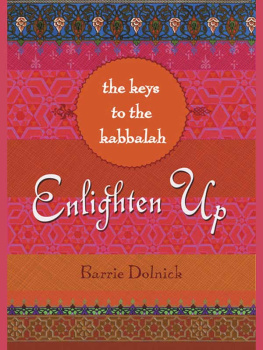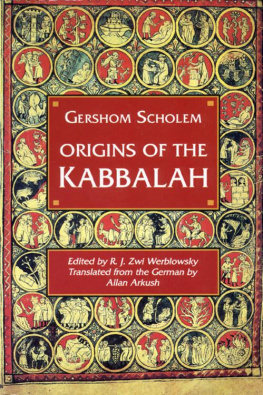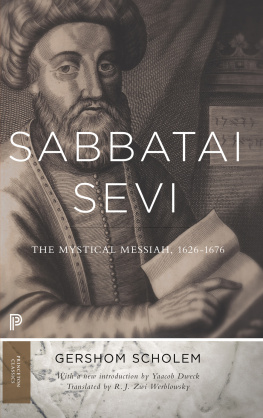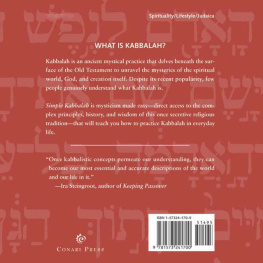Also by Gershom Scholem
The Correspondence of Walter Benjamin and Gershom Scholem, 193240 (Ed.)
From Berlin to Jerusalem: Memories of My Youth
Major Trends in Jewish Mysticism
The Messianic Idea in Judaism and Other Essays on Jewish Spirituality
On Jews and Judaism in Crisis: SelectedEssays
On the Kabbalah and Its Symbolism
Walter Benjamin: The Story of a Friendship
ZoharThe Book of Splendor: Basic Readings from the Kabbalah (Ed.)
English translation copyright 1991 by Schocken Books Inc.
Foreword copyright 1991 by Joseph Dan
All rights reserved under International and Pan-American Copyright Conventions. Published in the United States by Schocken Books Inc., New York, and simultaneously in Canada by Random House of Canada Limited, Toronto. Distributed by Pantheon Books, a division of Random House, Inc., New York. Originally published in Germany as Von der mystischen Gestalt der Gottheit: Studien zu Grundbegriffen d. Kabbala by Rhein-Verlag AG, Zurich, in 1962 and by Suhrkamp Verlag, Frankfurt am Main, in 1977.
Copyright 1962 by Rhein-Verlag AG, Zurich.
This translation originally published in hardcover by
Schocken Books Inc. in 1991.
Grateful acknowledgment is made to the Littman Library of Jewish Civilization and Oxford University Press for permission to reprint excerpts from The Wisdom of the Zohar, edited by Fishel Lachower and Isaiah Tishby, translated from the Hebrew by David Goldstein. This book is distributed in the United States by Bnai Brith International.
Library of Congress Cataloging-in-Publication Data
Scholem, Gershom Gerhard, 18971982
[Von der mystischen Gestalt der Gottheit. English]
The mystical shape of the godhead / Gershom Scholem; translated from the German by Joachim Neugroschel; edited and revised, according to the 1976 Hebrew edition, with the authors emendations, by Jonathan Chipman.
p. cm.
Translation of: Von der mystischen Gestalt der Gottheit.
1. CabalaHistory. 2. God (Judaism) (3)TransmigrationJudaism.
1. Neugroschel, Joachim. II. Chipman, Jonathan. III. Title.
BM526.S36413 1991 296.16dc20
90-52543
eISBN: 978-0-307-78702-6
v3.1
Contents
1.
Shi ur Komah:
ur Komah: THE MYSTICAL SHAPE OF THE GODHEAD
2.
Sitra A ra:
ra: GOOD AND EVIL IN THE KABBALAH
3. Tsaddik:
THE RIGHTEOUS ONE
4. Shekhinah:
THE FEMININE ELEMENT IN DIVINITY
5. Gilgul:
THE TRANSMIGRATION OF SOULS
6. Tselem:
THE CONCEPT OF THE ASTRAL BODY
Foreword by Joseph Dan
Gershom Scholem, when required to define his own scholarly enterprise, usually described himself as a historian of ideassomewhat more specifically, as a historian of religious ideas, one whose expertise was the history of Jewish mystical ideas. This volume contains six studies, which can unhesitatingly be described as the finest achievement in this field, and among the best examples of systematic studies in the history of ideas in the middle of this century. These studies pertain to some of the most basic and deep-rooted concepts in Jewish religion, such as the Shekhinah, the Tsaddik, and the anthropomorphic representation of the Godhead; here they are studied and elucidated in an exemplary methodology, accompanied by profound insight into the dynamics of history on the one hand and the multilayered, constantly changing human craving for approach to God on the other.
The first part of this foreword is dedicated to a brief description of the evolution of this book out of Scholems lectures before the Eranos Societys annual meetings in Ascona, Switzerland, between 1952 and 1961, and the second part, to a discussion of Scholems methodology.
I
The six studies translated into English in this volume comprise the second group of Scholems Eranos lectures to be published in book form. The first group, including five such studies, was published in the original German as Zur Kabbala und ihrer Symbolik in Zurich, in 1960, and in English as On the Kabbalah and Its Symbolism in New York, in 1965. It seems that Scholem regarded these eleven studies as one whole, and it is appropriate that all of them are available now, somewhat belatedly, to the English reader.
It is important to understand the place of these studies within the framework of Scholems complete works, in order to explain both the authors intentions and the structure and characteristics of this book. The studies were written during the most fruitful period of Scholems scholarly life, between the years 1949 and 1962. It was in this period that he wrote his two major works: his great monograph Sabbatai  evi: The Mystical Messiah, which was published in Hebrew, in two volumes, in 1957 but only two comprehensive books, the ones on Sabbatai Zevi and on the early Kabbalah mentioned above. All the others are collections of studies and essays, Kabbalistic texts, letters, and an autobiography. The only subjects that he brought to completion are those two, and they express his sense of priorities as well as his preference; both of them were completed while he was working on the studies presented here.
evi: The Mystical Messiah, which was published in Hebrew, in two volumes, in 1957 but only two comprehensive books, the ones on Sabbatai Zevi and on the early Kabbalah mentioned above. All the others are collections of studies and essays, Kabbalistic texts, letters, and an autobiography. The only subjects that he brought to completion are those two, and they express his sense of priorities as well as his preference; both of them were completed while he was working on the studies presented here.
Scholem wrote three summaries of the entire history of the Kabbalah: the first was his article on the subject for the German Encyclopaedia Judaica published in the 1930s; and the third was the series of articles on Kabbalah and Sabbatianism that he wrote for the Encyclopaedia Hebraica and the English Encyclopaedia Judaica (essentially the same material in both), which was published in the volume Kabbalah in Jerusalem in 1974.
It seems to me that the studies published here reflect in part Scholems realization that he was not going to write a comprehensive history of Jewish mysticism as a whole. Though he was at the peak of his scholarly powers, his reputation, and his influence, the enormity of the two tasks to which he dedicated most of his efforts and which he felt compelled to complete, may have caused him to doubt whether he could add to them it was quite obvious that the publication of that volume indicated his realization that there would be no continuation of the Sabbatai Zevi volumes; the collection of studies became the substitute. In a somewhat similar way, his Eranos lectures may be viewed as his substitute for a detailed, comprehensive history of Jewish mysticism.
In the beginning Scholem may not have realized the relationship, and especially the difference, between the two collectionsOn the Kabbalah and Its Symbolism and the present one. Yet this difference is important to the understanding of the development of these monographs. The first Eranos lectures, which appear in On the Kabbalah and Its Symbolism, are dedicated to a completely different aim than the present ones.only as viewed from without, by scholars and historians, but as viewed from within, by the Kabbalists themselves.











 ur Komah:
ur Komah: ra:
ra: evi: The Mystical Messiah, which was published in Hebrew, in two volumes, in 1957 but only two comprehensive books, the ones on Sabbatai Zevi and on the early Kabbalah mentioned above. All the others are collections of studies and essays, Kabbalistic texts, letters, and an autobiography. The only subjects that he brought to completion are those two, and they express his sense of priorities as well as his preference; both of them were completed while he was working on the studies presented here.
evi: The Mystical Messiah, which was published in Hebrew, in two volumes, in 1957 but only two comprehensive books, the ones on Sabbatai Zevi and on the early Kabbalah mentioned above. All the others are collections of studies and essays, Kabbalistic texts, letters, and an autobiography. The only subjects that he brought to completion are those two, and they express his sense of priorities as well as his preference; both of them were completed while he was working on the studies presented here.